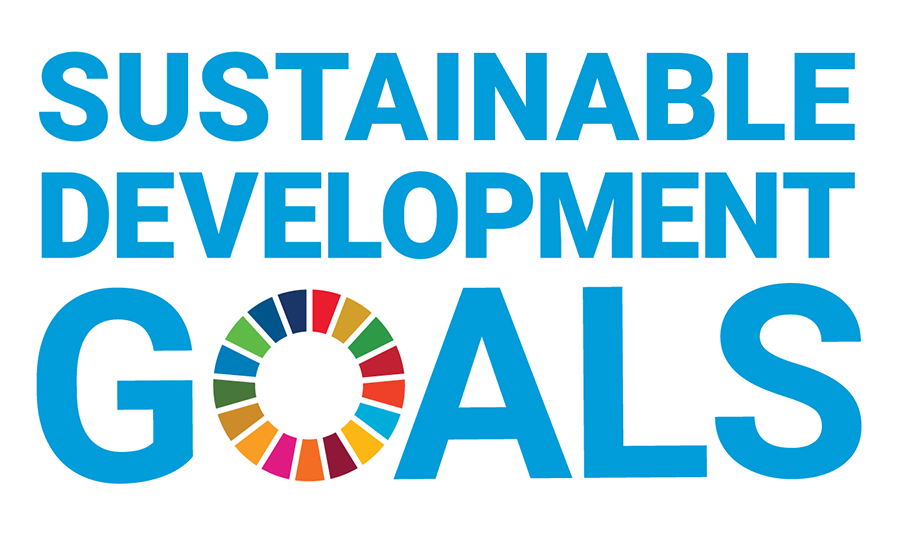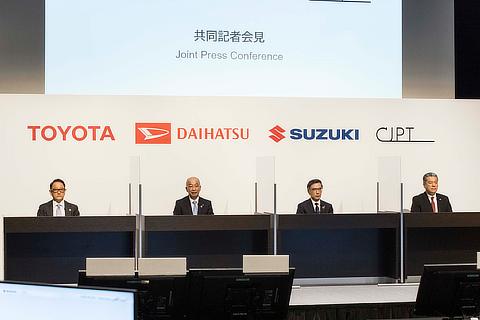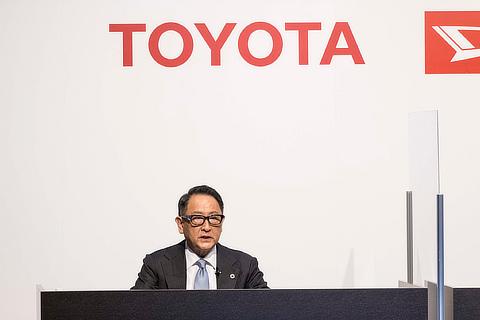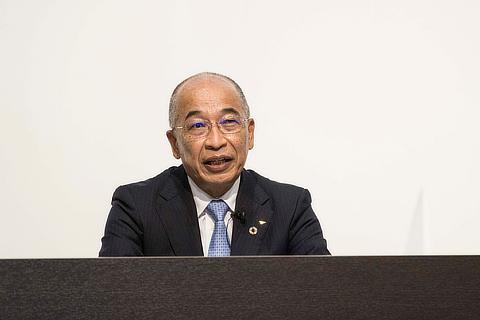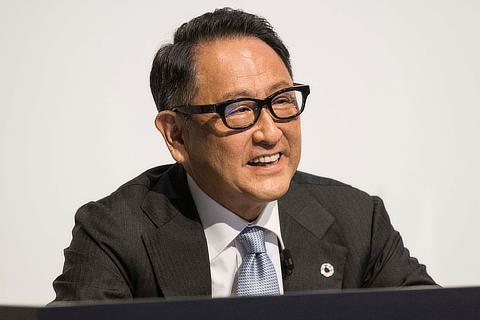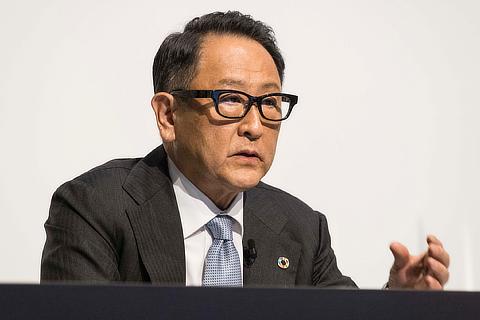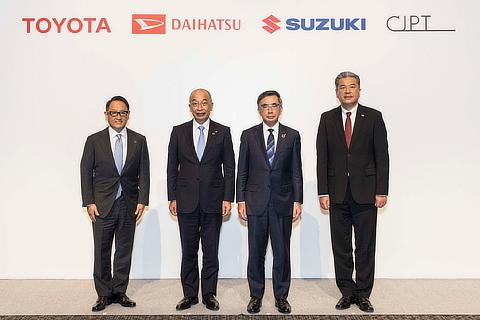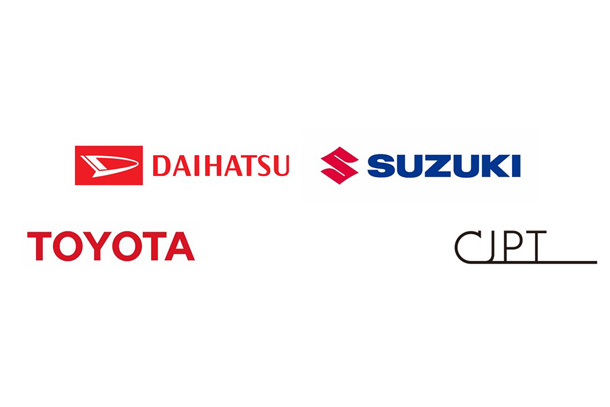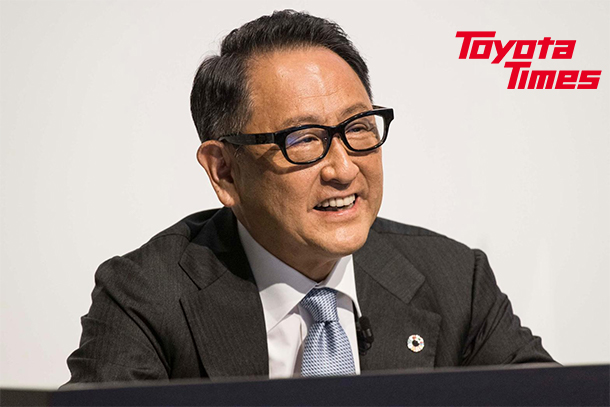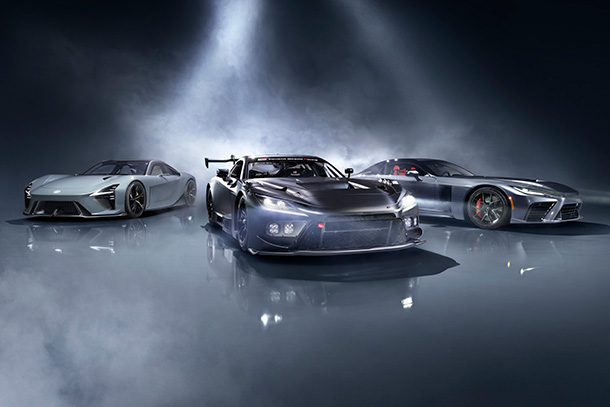Jul. 21, 2021
Video:
Joint Press Conference by Suzuki Motor Corporation, Daihatsu Motor Co., Ltd. and Toyota Motor Corporation
Suzuki Motor Corporation, Daihatsu Motor Co., Ltd. and Toyota Motor Corporation held a joint press conference in Tokyo on July 21, 2021, at 15:30 JST. Video from the press conference is available below.
Toyota President Akio Toyoda Remarks
Hello everyone. I would like to share with you my thoughts on this partnership.
"We want to help improve people's lives."
"We want to help leave a better Japan and a better planet for the next generation."
This is the mission of the automotive industry and the origin of the founding of the three companies present here today.
The commercial business partnership announced in March by Isuzu, Hino, and Toyota was prompted by the same idea.
Initiatives are now underway for easing the work situations of troubled colleagues on the front lines of transportation and for protecting the prosperous lifestyles that transportation supports.
With Suzuki and Daihatsu now joining us in this project, we will take on the challenge of improving the lives of people supported by minivehicles.
Of the 78 million cars owned in Japan, 31 million are minivehicles.
In many rural areas, minivehicles account for more than 50 percent of owned vehicles.
In Japan, 85 percent of roads are so narrow that they can only be used smoothly by minivehicles.
Roads make cars. Minivehicles are collectively the "people's car" made by the roads of Japan.
And they are a practical and sustainable lifeline of Japan that has continued to evolve along with people's lives.
However, great challenges now lay ahead of us. The CASE revolution and the necessity to achieve carbon neutrality are now forcing the world of minivehicles to undergo a profound transformation.
I believe that no matter how much the times change, we must not abandon either minivehicles or our customers.
For more than 60 years, Suzuki and Daihatsu have been protecting this lifeline and driving forward the market.
They continue to produce not only passenger cars but also commercial vehicles that support a variety of jobs such as those in agriculture and delivery.
Although mini-commercial vehicles present extreme challenges when thinking only in terms of profitability, they are indispensable to Japan.
That is what has driven these two companies to make effort, come up with new ideas, and keep going.
In other words, what they have been true to are the mission of the automotive industry and a user's perspective that puts customers first.
By working together, these two companies will be able to know the reality of nearly 70 percent of Japan's minivehicle users.
Nothing could make Toyota happier than to be able to apply its CASE technologies to further evolve minivehicles and help improve people's lives.
Moving forward, it is essential to think about vehicles as a set with infrastructure.
Leadership in both the government and the private sector is now needed more than ever.
Furthermore, achieving carbon neutrality is a challenge that can only be solved if all people and all industries work together.
Following the announcement of the partnership among Isuzu, Hino, and Toyota in March, many people, including local governments, infrastructure companies, and transportation companies, have told us that they would like to work together.
(Thank you very much.)
With Suzuki's and Daihatsu's joining this project and our working together, we will be able to expand our circle of cooperation to not only cover commercial vehicles but also minivehicles. With this expansion, I believe that we will be able to take one step closer to a better mobility society in which many people can be happier.
With a strong will and passion, and going beyond where we each normally belong, we are committed to taking action for Japan and the Earth.
I would like to ask for your understanding and support.
Thank you very much.
Suzuki President Toshihiro Suzuki Remarks
Hello everyone.
While watching the Toyota, Hino, and Isuzu press briefing to announce the CJP project in March this year, I realized that we could enrich society even more by not only connecting the distribution bases of large trucks but also connecting those distribution bases to customers' homes.
Speaking at a meeting of Suzuki's sales bases in early April, I shared my thoughts that, to achieve this, mini-commercial vehicles, which account for 58 percent of all commercial vehicles, also need to participate in the project, and, by doing so, we could contribute more to the world.
Since minivehicle standards were established in 1949, minivehicles have been used for a variety of purposes, such as in local transportation, in agriculture, forestry & fisheries, as well as in construction, retail, and logistics, to enrich people's lives by being close to them, including in their work.
In Japan, every industry is now endeavoring to achieve carbon neutrality, and the world of minivehicles is no exception.
Our mission is to bring to market minivehicles that are affordable and contribute to carbon neutrality and to continue to be an indispensable part of our customers' lives. However, accomplishing this mission on our own would be very difficult. The whole of society must work toward the same goal to achieve it.
Daihatsu felt the same way, and we had been discussing what we could do together. During such, Toyota approached us and invited us to work together to maintain Japan's lifelines. Because the philosophy and purpose of CJP resonated with us, we decided to join the project.
When Toyota proposed that Daihatsu and Suzuki join CJP, I was very happy to learn that President Toyoda was thinking the same as I was.
Our company's senior advisor, Osamu Suzuki, described minivehicles as "works of art" created under various restrictions such as those related to size, engine displacement, and above all, an affordable price.
We want to evolve minivehicles, which are collectively the "people's car" and lifeline, in stride with the changing times and to pass on to the future the baton of the "works of art" created by our predecessors as tools to enrich the lives of our customers. That is our mission and hope.
As like-minded colleagues, we would like to start by working together as five companies.
Thank you very much.
Daihatsu President Soichiro Okudaira Remarks
Hello everyone. I would like to talk about the background and details of this partnership.
As President Toyoda mentioned, there are 31 million minivehicles under ownership in Japan, which is about 40 percent of all owned vehicles in the market, with 8 million of them being mini-commercial vehicles.
The number of in-use minivehicles is steadily increasing, and there is a strong demand for mini-commercial vehicles not only among fleet customers but also among individual customers.
With such a large number of customers using minivehicles, we minivehicle manufacturers believe that it is our responsibility to make people's lives safer, more secure, and more prosperous by promoting carbon neutrality and by achieving the dissemination of CASE technologies and services for minivehicles.
Meanwhile, we have been offering customers affordable fuel-efficient technologies and advanced safety technologies by thoroughly pursuing low-cost manufacturing by way of simple factories, simple design elements, and slim fixed costs.
Also, our internal research shows that the current CO2 emissions of minivehicles from a life cycle assessment perspective are about 30 percent lower than non-minivehicle compact cars and comparable to those of small hybrid electric vehicles.
Our understanding is that it is no easy task to disseminate CASE technologies and services and to reduce CO2 emissions beyond the current level while keeping prices affordable. We have truly entered a once-in-a-century era of profound transformation.
It is extremely difficult to independently address these issues, and that necessitates a collaborative effort that goes beyond conventional frameworks.
Therefore, President Suzuki and I had been discussing for some time whether there were areas in which we could work together for the sake of our customers. We were then approached by President Toyoda, leading to what we are announcing today.
I am convinced that adding Toyota's CASE technologies to Isuzu and Hino, which are commercial vehicle professionals, and that participation in this project by Suzuki and Daihatsu, which have dedicated themselves to minivehicles, will create significant synergies. These include an integrated commercial vehicle infrastructure that covers, figuratively speaking, "from the main arteries to the capillaries", as well as the realization of electrification suitable for minivehicles through the fusion of advanced technologies and low-cost manufacturing.
I would like to explain the specific details of our participation in this partnership, including what we will consider going forward.
The first point is related to connected technologies.
Japan has about 60,000 logistics companies, roughly 70 percent of which are small-scale companies with fewer than 20 employees or one-person operations, and there is still a long way to go for automakers to meet the needs of individual customers. Through this partnership, we would like to seek frontline customer feedback that has thus far escaped us. And we would like to build an infrastructure that connects various elements, including data, of trucks to mini-commercial vehicles, which are responsible for the last mile, to improve the efficiency of logistics as a whole.
The second point has to do with advanced safety technology, such as advanced driver-assistance systems that protect our customers.
We will bring together the technologies and know-how of each company and study the development of advanced safety technologies that are more affordable with a view toward future development.
The third point concerns the electrification of minivehicles, including mini-commercial vehicles.
Toward achieving carbon neutrality, we will take on the challenge of developing affordable electrified minivehicles through technological cooperation on electric components and by consolidating development resources.
By collaborating on the three points, we will aim to include minivehicles in the societal implementation of CASE technologies and services. We, too, will put into practice President Toyoda's "Give it a try" thinking.
As of today, Suzuki and Daihatsu are now members of the Commercial Japan Partnership, a commercial vehicle project by Isuzu, Hino, and Toyota, and we will begin our efforts with commercial vehicles as the starting point. To promote collaboration, Suzuki and Daihatsu will each acquire 10 percent of Commercial Japan Partnership Technologies, which is the joint venture for the project, through a share transfer.
As a manufacturer of minivehicles, Daihatsu will continue to provide products and services while insisting on products that are compact, light, and low-cost so that minivehicles, which serve as a lifeline, will remain affordable and accessible to our customers.
Through this partnership, we will accelerate such efforts.
Thank you very much.
Related Content
- Suzuki and Daihatsu Join Commercial Japan Partnership for Dissemination of CASE Technologies in Mini-commercial Vehicles
- Toyota TimesAiming to Improve Logistics and Lives of People: Toyota's New Collaboration with Suzuki and Daihatsu
- Toyota TimesMessage from Akio Toyoda to Osamu Suzuki, Senior Advisor of Suzuki and Legendary Automotive Leader of Japan
Toyota Motor Corporation works to develop and manufacture innovative, safe and high-quality products and services that create happiness by providing mobility for all. We believe that true achievement comes from supporting our customers, partners, employees, and the communities in which we operate. Since our founding over 80 years ago in 1937, we have applied our Guiding Principles in pursuit of a safer, greener and more inclusive society. Today, as we transform into a mobility company developing connected, automated, shared and electrified technologies, we also remain true to our Guiding Principles and many of the United Nations' Sustainable Development Goals to help realize an ever-better world, where everyone is free to move.
- SDGs Initiatives
- https://global.toyota/en/sustainability/sdgs/

